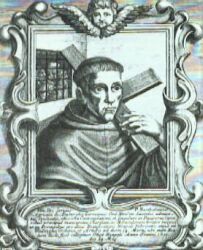Bartholomew Agricola
Bartholomäus Agricola OFMConv (* around 1560 in Amberg ; † 23 May 1621 in Naples ; actually Bartholomäus Pauer ) was a German minorite and composer .
Life
Agricola was born as the son of the Amberg master cooper Hanns Pawer. He received his musical education in his hometown Amberg, where the composer Mathias Gastritz worked as organist at St. Martin . In the protocols of the church council on December 31, 1577 it is noted that “Barth. Agricola "next eleven other students for exams for the passage of the urban Lutheran grammar school in the electoral Calvinist embossed Pädagogium had not appeared. It is possible that the denominational disputes were the reason why Agricola renounced the advantages of training in the prestigious pedagogy and left his hometown. In Italy he converted to Catholicism and tried to be accepted into a Franciscan convent. A later return to Amberg and the attempt to convert his family to Catholicism, ended in a rift with the family and his hasty flight.
Agricola's earliest known compositions are in a Karlsruhe choir book from 1575 to 1585. His second well-known work is a codex from the Franciscan convent Tagliacozzo , which is dated to the year 1600. The manuscript also contains four-part antiphons by Costanzo Porta , whose pupil Agricola may have been in the 1590s.
Agricola worked for three years in Assisi , where he was responsible for church music and wrote his first writings on asceticism . After staying in other Franciscan convents in Bari , Trani , Bitonto and Molfetta and being ordained a priest , Agricola finally came to the monastery of San Lorenzo Maggiore in Naples . There he worked as a popular preacher and devoted himself to caring for the poor and the sick.
On May 23, 1621 he died in the reputation of saintliness. His grave site in Naples is traditionally the destination of many pilgrims. After the original tomb was destroyed in World War II, its relics were transferred to the Basilica of San Lorenzo Maggiore in 1987 . A beatification procedure was approved shortly after his death, but was not formally initiated until over a century later and then initially discontinued; recently it was resumed. A portrait in the Schönau monastery church shows him in habit with a cross on his shoulder.
literature
- Emmeram H. Ritter: Witnesses of Faith. Saints, blessed and servants of God in the diocese of Regensburg. Josef Kral, Abensberg 1989, ISBN 3-87442-027-2
- Ekkart Sauser: Bartholomäus Agricola. In: Biographisch-Bibliographisches Kirchenlexikon (BBKL). Volume 16, Bautz, Herzberg 1999, ISBN 3-88309-079-4 , 72.
- Karl Schwämmlein : A Catholic Composer of the Reformation Era . Series of articles in the Amberger Zeitung , February – June 1992
- Karl Schwämmlein: Bartholomäus Agricola. A Catholic composer from Amberg during the Reformation. In: Oberpfälzer Heimat , 37th volume. Knauf, Weiden 1993, pp. 81-90
- Bartholomaeus Agricola . In: Johann E. Stadler , Franz Joseph Heim, Johann N. Ginal (Eds.): Complete Lexicon of Saints ... , Volume 1 (A – D), B. Schmid'sche Verlagsbuchhandlung, Augsburg 1858, p. 400 .
Web links
- The Servant of God P. Bartholomäus Bauer OFMConv. (in Italy "Agricola") (1560–1621) , information from the Episcopal Ordinariate Regensburg (PDF; 139 kB)
- P. Bartholomäus Bauer OFMConv. Archived from the original on November 8, 2011 ; Retrieved August 27, 2012 .
- Antonio Borrelli: Venerabile Bartolomeo Agricola (Italian)
| personal data | |
|---|---|
| SURNAME | Agricola, Bartholomew |
| ALTERNATIVE NAMES | Pauer, Bartholomäus; Bauer, Bartholomäus; Agricola, Bartolomeo |
| BRIEF DESCRIPTION | Franciscan minorite and composer |
| DATE OF BIRTH | around 1560 |
| PLACE OF BIRTH | On the mountain |
| DATE OF DEATH | May 23, 1621 |
| Place of death | Naples |
